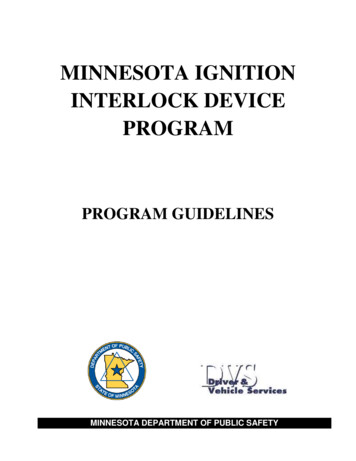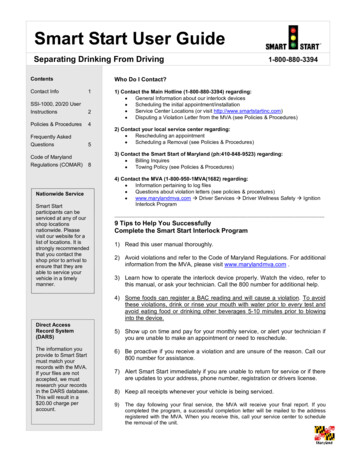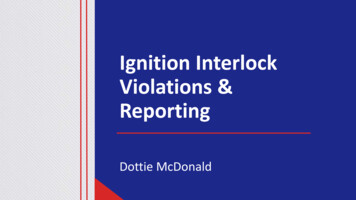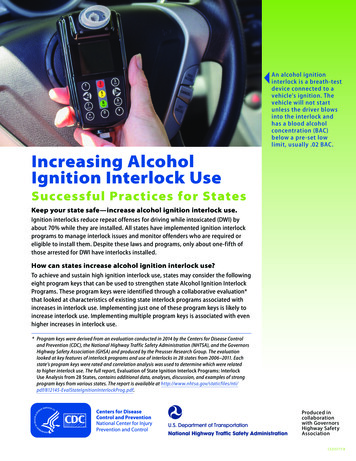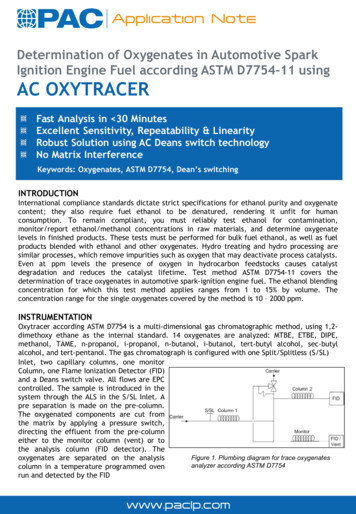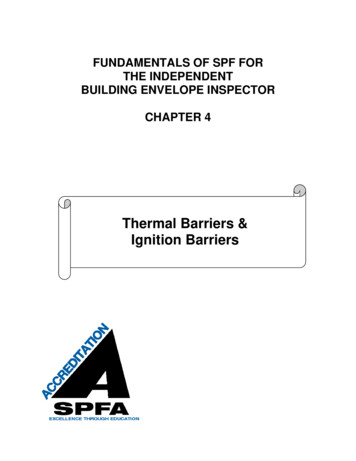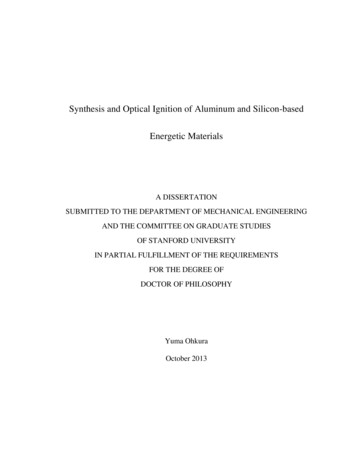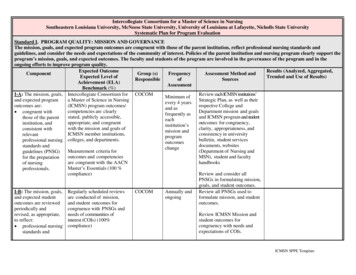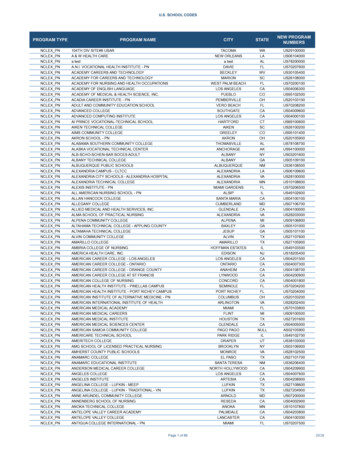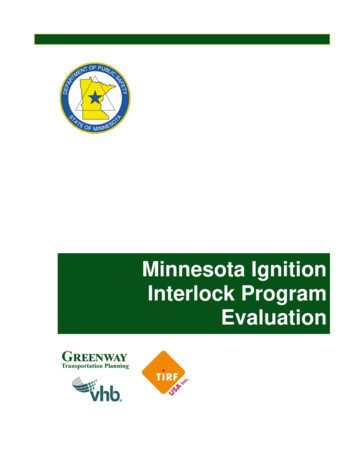
Transcription
Minnesota IgnitionInterlock ProgramEvaluation
GREENWAYMinnesota IgnitionInterlock ProgramEvaluation- FinalReportSubmitted to:Office of Traffic Safety445 Minnesota Street, Suite 150St. Paul, MN 55101-5150By:Greenway Transportation PlanningVanasse Hangen Brustlin, Inc.TIRF USAGreenway Transportation Planning1338 Keston St, St Paul MN 55108 USATel 1 651 788 7801www.greenway-consulting.comJob number: J1051
Office of Traffic SafetyMinnesota Ignition Interlock Program EvaluationFinal ReportTable of Contents1Report Summary. 12Introduction . 163Background. 21453.1Problem of Impaired Driving in Minnesota. 213.2History of Ignition Interlock in the State . 223.3Minnesota’s Ignition Interlock Device Program . 28Evaluation Methodology . 404.1Overview of the Evaluation Design . 404.2Data Sources . 514.3Data Analysis . 54Findings . 575.1Who participates? . 575.2What is the license type of those enrolled in theprogram? . 625.3What is the participation rate?. 635.4How long do they stay in the program? . 655.5When do they exit the program and what is theattrition rate annually? . 665.6What are the reasons for leaving the program? . 675.7Who does not participate in the program?. 675.8What is the program participation rate over time?. 685.9Who successfully completes the program? . 695.10Who recidivates and in what length of time? . 715.11While in the program, how many re-offend, howoften, and who are they?. 815.12How many failed AC tests were logged on thedevice? . 825.13How many times did participants use the devicewhile in the program? What was the mileagedriven during participation? . 835.14What was the rate of failed AC tests over theprogram? . 84Greenway Transportation Planning
Office of Traffic Safety67Minnesota Ignition Interlock Program EvaluationFinal Report5.15Who supplies failed AC tests? . 845.16What program factors predict success? . 875.17What is the program completion rate? . 905.18How many continue to use ignition interlock aftersuccessfully completing the program? . 915.19How successful is the ignition interlock programin bringing program participants to completionwithin the expected time frame? . 935.20What is the number of canceled drivers’ licensesand who is cancelled-inimical to public safety?. 945.21What are the reasons for cancellation? . 955.22How many re-apply?. 955.23What are the numbers of citations and crashes ofthose in the program? . 975.24What is the effectiveness of the program inreducing DWI re-offenses? . 985.25What other variables are affected by participatingand do they influence the program graduate’sperception and intent of repeating the act ofimpaired driving? . 985.26What is the impact of the ignition interlockprogram on public safety? . 101Conclusions and Recommendations. 1046.1Conclusions . 1046.2Recommended Future Actions . 106References . 112Greenway Transportation Planning
Office of Traffic SafetyMinnesota Ignition Interlock Program EvaluationFinal ReportTables, Figures and AppendicesTable 1-1: Ignition Interlock Program Participant Profiles1 . 5Table 2-1: Alcohol Involvement in Fatal Traffic Crashes, by State,2005 and 2014 . 16Table 3-1: Program Participants Summary 2013-151 . 28Table 3-2: Driver Reinstatement Options . 38Table 4-1: Research Questions and Data Elements . 42Table 5-1: Ignition Interlock Program Participant Profiles1 . 58Table 5-2: Number of Vehicles Owned by Survey RespondentsBefore and During Program Participation . 59Table 5-3: Race and Ethnicity of Survey Respondents. 59Table 5-4: Marital Status of Survey Respondents. 60Table 5-5: Number of Children Reported by Survey Respondents . 60Table 5-6: Highest Education Level Achieved by SurveyRespondents . 61Table 5-7: Income Bracket of Survey Respondents . 61Table 5-8: Prior Offense History and License Status at Enrollment1 . 62Table 5-9: AC Level at Time of Arrest; or Test Refusal1 . 63Table 5-10: Total Enrollments by Year and Prior Offense1 . 63Table 5-11: Total Eligible Drivers (2011–16)1 . 64Table 5-12: Participation Rates by Year and Prior Offense1 . 65Table 5-13: Duration Spent in the Program1 . 66Table 5-14: Enrollments, Completions and Terminations by Year1 . 67Table 5-15: Reasons for Leaving the Program . 67Table 5-16: Participation Rate by Year and Age Group1 . 68Table 5-17: Participation Rate by Year and Sex1. 69Table 5-18: Participation Rate by Year and County Type1 . 69Table 5-19: Completion Rates for Participants by Age, Sex, and Typeof County1 . 70Table 5-20: Recidivism Rates for Participants by Age, Sex andCounty Type . 72Greenway Transportation Planning
Office of Traffic SafetyMinnesota Ignition Interlock Program EvaluationFinal ReportTable 5-21: Number of Drivers who Completed the Program andRecidivated by Age and Time to Recidivism. 73Table 5-22: Number of Drivers who Completed the Program andRecidivated by Sex and Time to Recidivism. 73Table 5-23: Number of Drivers who Completed the Program andRecidivated by County Type and Time to Recidivism . 73Table 5-24: Number of Drivers who Completed the Program andRecidivated by DWI Offense History and Time toRecidivism . 74Table 5-25: Number of Drivers who Completed the Program andRecidivated by AC Level at Time of Arrest and Time toRecidivism . 74Table 5-26: Cox-proportional Hazard Model Parameter for BothParticipant and Comparison Group Combined . 77Table 5-27: Cox-proportional Hazard Model Parameter for ParticipantGroup. 78Table 5-28: Number of Enrollees who Re-offended by Age Groupand Number of DWI Arrests While in the Program . 82Table 5-29: Number of Enrollees who Re-offended by Sex andNumber of DWI Arrests while in the Program . 82Table 5-30: Number of Enrollees who Re-offended by County Typeand Number of DWI Arrests while in the Program . 82Table 5-31: Number of Failed AC Start up Tests . 83Table 5-32: Number of Failed Rolling Retests . 83Table 5-33: Participants' Trip Durations . 84Table 5-34: Start up Failure by Age . 85Table 5-35: Rolling Retest Failure by Age. 85Table 5-36: Start up Failure by Sex . 86Table 5-37: Rolling Retest Failure by Sex . 86Table 5-38: Start up Failure by County Type. 86Table 5-39: Rolling Retest Failure by County Type . 86Table 5-40: Start up Failure by AC Level at Time of Arrest . 87Table 5-41: Rolling Re-test Failure by AC Level at Time of Arrest. 87Table 5-42: Cox Proportional Hazard Model Parameters for ProgramCompletion Analysis. 88Greenway Transportation Planning
Office of Traffic SafetyMinnesota Ignition Interlock Program EvaluationFinal ReportTable 5-43: Device Retention as a Function of Age . 92Table 5-44: Device Retention as a Function of Sex. 92Table 5-45: Device Retention as a function of County Type. 92Table 5-46: Device Retention as a Function of AC Level at Time ofArrest. . 93Table 5-47: Completion Timeframes for Participants whoSuccessfully Completed the Program . 94Table 5-48: Cancelled-IPS Participants by Age, Sex and CountyType . 94Table 5-49: Number of Cancelled Drivers' by AC Levels at Time ofArrest . 95Table 5-50: Number of Licenses Cancelled by Reason forCancellation . 95Table 5-51: Number of Drivers who Re-applied by Age Group andNumber of Re-applications . 96Table 5-52: Number of Drivers who Re-applied by Sex and Numberof Re-applications . 96Table 5-53: Number of Drivers who Re-applied by County Type andNumber of Re-applications . 96Table 5-54: Number of Enrollees who had DWI Violation, MovingViolation or Either During Enrollment . 97Table 5-55: Number of Drivers from the Comparison Group byNumber DWI Violations, Moving Violations or EitherDuring Comparable Period . 97Table 5-56: Pairwise Comparisons of Participants and ComparisonGroup on Numbers of Violations . 98Table 5-57: Risk Ratios for Estimating the Probability of CompletingProgram . 100Table 5-58: Total Crash, DWI Arrests, Fatalities and ProgramEnrollment: Years 2010–15 . 101Greenway Transportation Planning
Office of Traffic SafetyMinnesota Ignition Interlock Program EvaluationFinal ReportFigure 3-1: Total Crashes, DWI Arrest and Related Fatalities 2006–2015 . 21Figure 3-2: Interlock Program Staffing Structure . 37Figure 5-1: Completion Rates for Revoked and Cancelled-IPSParticipants . 71Figure 5-2: Kaplan-Meier Survival Curves for Interlock and NonInterlock Drivers. . 76Figure 5-3: The Relationship Between Number of Startup TestFailures During Enrollment and the Relative Risk ofRecidivism . 80Figure 5-4: The Relationship Between Number of Rolling Re-testFailures During Enrollment and the Relative Risk ofRecidivism . 81Figure 5-5: Probability of Interlock Program Completion Over Time . 91Figure 5-6: Total Crash, DWI Fatalities and Program Enrollment2010–15. 102Appendix A – Definition of TermsAppendix B – Minnesota Ignition Interlock Device Program GuidelinesAppendix C – Data Request and Survey FormsGreenway Transportation Planning
Office of Traffic SafetyMinnesota Ignition Interlock Program EvaluationFinal ReportACKNOWLEDGEMENTSThis report was made possible through the efforts and cooperation ofvarious parties involved in Minnesota’s Ignition Interlock Program.The authors of this report would like to extend their thanks andappreciation to the Office of Traffic Safety, Driver and VehicleServices, MN.IT Services and ignition interlock vendor organizationsand their representativesGreenway Transportation Planning
Office of Traffic SafetyGreenway Transportation PlanningMinnesota Ignition Interlock Program EvaluationFinal Report
Office of Traffic SafetyMinnesota Ignition Interlock Program EvaluationFinal Report1 Report SummaryAlthough there have been trending reductions in impaired drivingfatalities over the past few years, Driving While Impaired (DWI) arrestsand impaired driving fatalities are still a problem in the US. The NationalHighway Traffic Safety Administration (NHTSA) reported 9,967 alcoholimpaired driving fatalities in 2014, which accounted for 31% of total fataltraffic crashes (NHTSA 2015). In 2015 NHTSA reported that 35,092people died in motor vehicle traffic crashes, an increase of 7.2 percentover the 32,744 fatalities reported in 2014. This is the largest percentageincrease in nearly 50 years.Impaired driving is a serious problem in Minnesota. In 2014, 111 peoplewere killed in alcohol-related crashes. This accounted for 31% of all trafficfatalities in Minnesota. In 2015, the number rose. One hundred thirtyseven people were killed, more than 2,203 were injured, and costsamounted to more than 285 million. In an attempt to deter motoristsfrom driving while impaired and thereby enhancing road safety, the useof ignition interlocks became law in Minnesota on July 1, 2011 withMinnesota Statutes 171.306 - Ignition Interlock Device Program.Research has shown that interlock programs reduce the incidence ofimpaired driving when an interlock device is installed in the vehicle. Astudy of New Mexico’s interlock program found that offenders whoparticipated in the program had a 61% lower recidivism rate while thedevice was in use in their vehicle, and a 39% lower recidivism ratefollowing the removal of the interlock compared to offenders who neverhad the device installed (Marques et al. 2010).The goal of this project is to evaluate the effectiveness of the interlockprogram in Minnesota and provide a comprehensive report to theMinnesota Office of Traffic Safety (OTS) based on the results of theevaluation.BackgroundThe state’s first ignition interlock pilot program was established in AnokaCounty in 2002. In 2007, the Minnesota Legislature authorized theDepartment of Public Safety (DPS) to conduct a two-year pilot in onerural and one metropolitan county. In 2009, the Minnesota Legislatureexpanded the two-county pilot statewide. This ran concurrent with aDriver’s License Administrative Sanctions (DLAS) work group formed tothoroughly review administrative sanctions imposed on a person fordriving impaired.The current statewide program became effective on July 1, 2011 andmandates that:Greenway Transportation PlanningPage 1
Office of Traffic SafetyMinnesota Ignition Interlock Program EvaluationFinal Report First and second offenders may voluntarily participate in theinterlock program (e.g., install the interlock instead of serving thehard revocation period). DWI offenders with a 0.16 and above alcohol concentration (AC)will be required to have an interlock device installed on any vehiclethey drive or lose their driving privileges for one year for firstoffense and two years for second offense. Repeat offenders with three or more DWIs in a 10-year period willbe required to use interlocks. Interlock users will regain full or limited driving privilegesimmediately after the offense, ensuring they are driving with a validlicense and not a threat on the roadway. Interlocks will be used to monitor chronic DWI offenders (three ormore DWIs in 10-year period) to verify chemical use.A provision was also recently added that requires anyone cited for acriminal vehicle operation (CVO) “bodily harm” to “great bodily harm” toinstall an interlock device on their vehicle.Minnesota’s interlock program is an administrative type jointly run byOTS and Driver and Vehicle Services (DVS) Divisions of DPS. DVSmanages enrollment, oversees device use and implements sanctions forparticipants who violate program requirements. OTS provides financialsupport, communication, education and outreach. DVS also manages theignition interlock website, which facilitates enrollment, education andpartnerships.An individual whose driver’s license has been revoked under MinnesotaChapter 169A for an impaired driving incident or canceled underMinnesota Statute section 171.04, subdivision 1, clause (10) may applyfor the ignition interlock device program if they meet the requirements.The length of time a participant must be on the ignition interlock programdepends on the number of prior offenses on the driving record and thelength of time the participant has lost their driving privilege. This timeperiod may be extended for any additional ignition interlock violations.Minnesota’s interlock program follows several evidence-based practices toincrease participation and effectiveness, including: All-offender eligibility Removal of hard suspension periods Performance-based exit Treatment, alcohol education or bothGreenway Transportation PlanningPage 2
Office of Traffic SafetyMinnesota Ignition Interlock Program EvaluationFinal ReportMinnesota does not have a dedicated indigency program, but participantsmay qualify for reduced installation, removal and monitoring fees. Inaddition, Minnesota generally follows the standardized best practicesrecommendations identified by the Association of Ignition InterlockProgram Administrators (AIIPA) including device certification bestpractices.Evaluation MethodologyThe study asked 26 research questions. These questions were refinedduring the course of the evaluation in response to the availability ofparticipant data.Participation Evaluation – This evaluates participation rates, participantcharacteristics and number of participant DWI incidents. The analysisused demographic data of program participants and non-participatingDWI offenders.Outcome Evaluation – This evaluation looks at the performance of theparticipants during and after completion of the interlock program.Performance indicators included program completion rate, recidivism(during and after completion) and device failed attempts, among others.Data SourcesDriver and Motor Vehicle Records - The target population for thisevaluation included all drivers with DWI convictions since the start of thetwo-county pilot program in July 1, 2007. Data included basicdemographic information, vehicle ownership, driving convictions andrelated interlock-program events. During this process, the entire drivingand vehicle history of 20,346 unique program participants plus roughly200,000 DWI-convicted non-participant drivers we
St. Paul, MN 55101-5150 . By: Greenway Transportation Planning Vanasse Hangen Brustlin, Inc. TIRF USA . Greenway Transportation Planning . 1338 Keston St, St Paul MN 55108 USA Tel 1 651 788 7801 www.greenway-consulting.com . Minnesota Ignition Interlock Program Evaluation- Final Report . Job number: J1051 .
